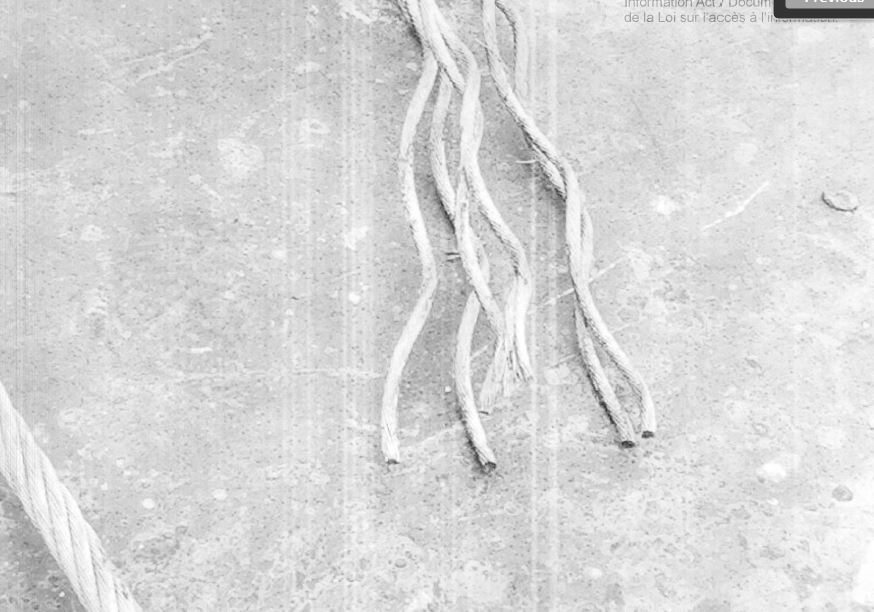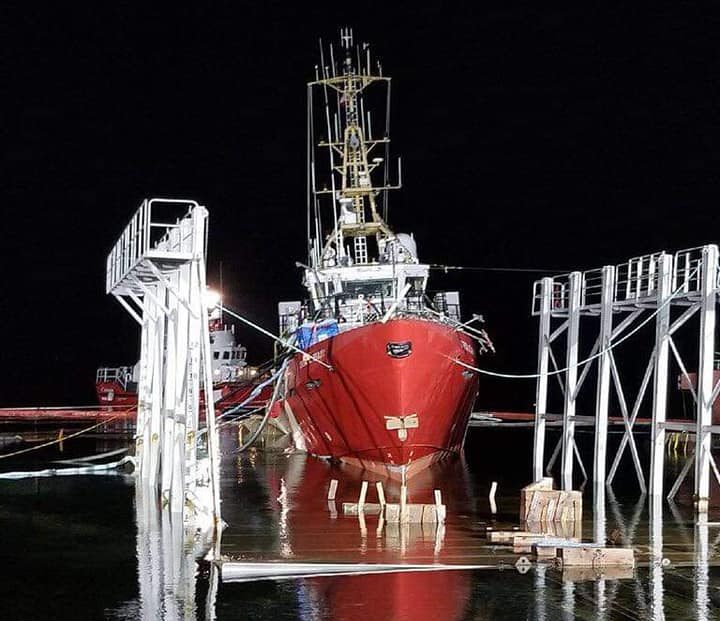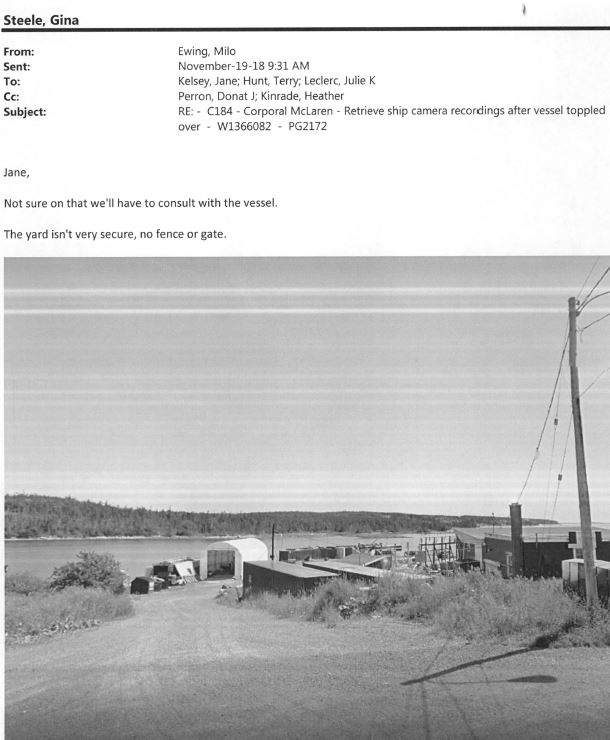They found it shortly before 8:00 a.m. AT on a chilly November day in Nova Scotia.

CCGS Corporal McLaren, a 42.8-metre-long patrol vessel, was listing to its starboard side. At least a third of the vessel — clad in the red and white colours of Canada’s Coast Guard — lay partially submerged in the icy water of Sambro Harbour.
The workers at the Canadian Maritime Engineering dockyard in Sambro Head, N.S., were quick to inform members of the Department of Fisheries and Oceans (DFO) that their vessel, meant to be undergoing a month-long refit, had slipped out of its cradle.
But as investigators, fisheries officials and senior analysts gathered at the scene, it did not take long to determine that the damage to the vessel was the result of sabotage.
“The cable break looks awfully clean,” said one DFO analyst in an email to his colleagues a little more than three hours after the vessel was discovered.
The details of the incident are gleaned from 349 pages of internal emails, photographs, and reports released by the DFO under the federal government’s access-to-information law.
READ MORE: CCGS Corporal McLaren re-floated after sabotage in Nova Scotia fishing village
Officials would come to understand that sometime over the night of Nov. 16, 2018, the primary cable and a backup line responsible for keeping CCGS McLaren in its berth had been cut — possibly by an angle grinder — with the remaining anchors snapping under the ship’s weight.
Power cables were torn from the vessel as it slid into the water. Multiple compartments on the vessel were filled with icy seawater, damaging computer equipment and rendering wiring useless.
The damage, according to preliminary estimates, could cost as much as $5 million to repair.
Now, five months later, the vessel remains in Sambro, N.S.
Repairs have yet to begin and the DFO has confirmed to Global News that a complete cost estimate must be carried out before they do. As of April 11, there is no date for when a cost estimate will be complete.
The RCMP declined to provide details of what they have found but say their investigation is ongoing.
They confirm that no arrests have been made and no one has been charged.
WATCH: Vandalism of coast guard vessel ‘upsetting’ and personal to namesake’s family members

Fallen hero

Get daily National news
CCGS McLaren, one of nine Hero-class vessels built for $227 million, was launched from the Irving Shipyards in Halifax in 2013 and tasked with fisheries enforcement and maritime security while also providing search and rescue capabilities and pollution control.
Built to patrol the Canadian coast, Hero-class vessels are named after exemplary soldiers, veterans, police officers, DFO employees and Canadian Coast Guard officers.
The vessel’s namesake was Cpl. Mark Robert McLaren of Peterborough, Ont. McLaren was killed along with Pte. Demetrios Diplaros and Warrant Officer Robert Wilson on Dec. 5, 2008, when their armoured vehicle ran over an improvised explosive device in Kandahar Province, Afghanistan.
During the ambush, McLaren crawled through enemy fire to help his team’s injured interpreter. He was awarded the Medal of Military Valour for his actions.
Extensive water damage could result in vessel’s write off
Timothy Hiu-Tung Choi, a doctoral student at the University of Calgary’s Centre for Military and Strategic Studies specializing in maritime security and the Canadian navy, says the time being taken to get what is essentially a “brand new vessel” back into service does not bode well for some of the vessel’s systems.
“Extensive testing would have to be done on all those items to ensure they still work properly — and if they don’t, replacements would have to be procured and fitted.”
Emails released to Global News indicate that the DFO found little in the way of hull damage and that much of the focus on repairs would be confined to the interior of the ship.
Choi said the delay in a cost estimate may not mean anything and that repairs are always a tricky thing to estimate as no two incidents are identical.
WATCH: Scrap, don’t fix, storied Coast Guard ship, shipyard says

However, any major damage to the vessel’s electronics could also signal a need to conduct significant structural repairs.
“Given that electronic systems and equipment like engines constitute a significant portion of a ship’s cost (for military vessels, these constitute the majority of the costs), major damage to these may well result in the ship being written-off,” Choi wrote.
READ MORE: COMMENTARY — Canada’s military procurement legacy somehow gets even stupider
Security an issue
The incident that damaged CCGS McLaren raises questions over where and how Canadian vessels are repaired.
The Canadian Maritime Engineering dockyard where CCGS McLaren was being refitted had no fence or gate — an issue that DFO officials mentioned in their emails to one another.
“The yard isn’t very secure,” one official wrote.
Emails indicate that security cameras at the yard were described as “unreliable” and that investigators were reliant on the cameras onboard CCGS McLaren.
Those didn’t prove any more useful.
“No update from the police whom looked at the closed circuit tv camera coverage from the ship, except maybe 1 or 2 flashlights outside the ship,” said an official in an email dated Nov. 21.
Others raised questions over how the contract was awarded to the dockyard in the first place.
“Will this incident — security issue and drydock venerability [vulnerability] — be addressed by [Public Services and Procurement Canada] in contracts awarded going forward? Who assessed the yard for compliance with the security requirement?” an official asked.
The documents released do not provide an answer to those questions and the DFO referred Global News to Public Services and Procurement Canada (PSPC) when asked.
The procurement agency did not provide answers to Global News by deadline.
Choi said he was surprised that “the refit yard at Sambro lacked any basic security precautions,” as Hero-class vessels are built with equipment that allows them to communicate with classified networks, including the Canadian Armed Forces.
“It seems to me that basic shipyard security should be one of the criteria that the CCG and PSPC should include from now on when taking bids for refit contracts,” Choi said.
WATCH: Salvage team moving cautiously on recovery of sabotaged coast guard ship

A gap in service
While CCGS McLaren has been in dry dock, other vessels have been shifted to cover its maritime enforcement duties, DFO confirmed to Global News. In particular, vessels that are normally assigned to central Canada have been shifted to cover the Atlantic region.
Choi says it’s something that would not normally be an issue during winter and early spring due to reduced ship traffic but that could soon change.
The vessels that have been assigned to cover off CCGS McLaren’s duties will either have to be assigned to the Atlantic region on a more permanent basis or a gap in service will remain unfilled.
With files from The Canadian Press











Comments